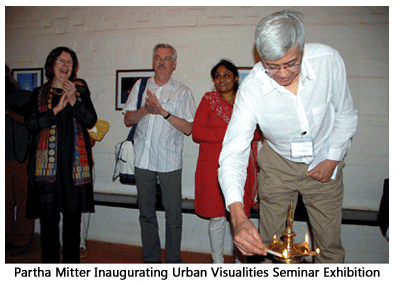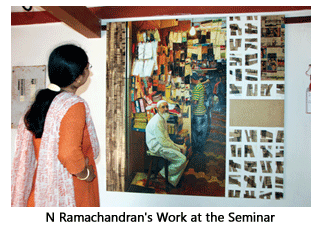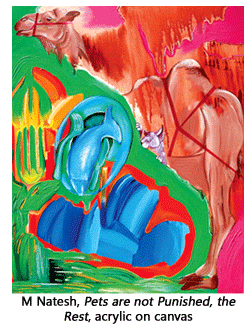- Prelude
- Editorial
- Subodh's 'return home'
- A Conversation with TV Santosh
- It's a War Out There
- Raqib Shaw
- Illusions in Red from a very British Indian Sculptor
- Stand Alone: Shibu Natesan
- Reading Atul Dodiya
- Bharti Kher: An Obsession for Bindis
- Bose Krishnamachari
- The Image - Spectacle and the Self
- From Self-depiction to Self-reference: Contemporary Indian Art
- GenNext: The Epitome of New Generation Art
- Kolkata's Contemporary Art A Look in the Mirror
- Innovation Coalesced with Continuing Chinese Qualities
- Kala Bhavana-Charukala Anushad Exchange Program
- Montblanc Fountain Pens
- Dutch Designs: The Queen Anne Style
- Bangalore Dance Beat
- Decade of change
- Distance Between Art & It's Connoisseur
- What Happened and What's Forthcoming
- 3rd India Art Summit
- New Paradigms of the Global Language of Art
- Black Brown & The Blue: Shuvaprasanna
- Art Events Kolkata
- Musings from Chennai
- Art Bengaluru
- Printmaker's Season
- Mumbai Art Sighting
- The Pause of Profound Stillness
- Previews
- In the News
- The Rebel Queen: An icon of her own times yet looked down upon
ART news & views
Musings from Chennai
Volume: 3 Issue No: 14 Month: 3 Year: 2011
January – Febryary 2011
by Vaishnavi Ramamathan
January saw two important events that brought art to the streets of Chennai. The first was Chennai Sangamam, a festival that happens every year around the time of Pongal. Like last year, this year's festival too converted the entire city into a giant stage with folk art performances, dances and music throughout Chennai. While the Chennai Sangamam is normally accompanied by special shows in the city's art gallery, this year's visual art initiatives were relatively low key.  This was perhaps because Chennai's art circle is busy gearing up for Chennai's version of the Art Summit that will be held in March. This event which will include camps as well as special exhibitions throughout the city is scheduled to be held between 20th and 26th March, 2011.
This was perhaps because Chennai's art circle is busy gearing up for Chennai's version of the Art Summit that will be held in March. This event which will include camps as well as special exhibitions throughout the city is scheduled to be held between 20th and 26th March, 2011.
DakshinaChitra hosted Urban Visualities- Sites and Sights of Popular Art, a seminar on popular culture between 28th and 30th January, 2011. This seminar not only included paper presentations and interactive sessions but also a unique pre-seminar workshop for artists. As part of this workshop, the public could paint a wall space in Chennai. Along with this, banner artists Selvam and Muthu were invited to paint on a subject of their choice and the subjects that they chose included the all pervasive Rajnikanth, Mother Teresa, market scenes etc. Rajnikanth also made an entry into media practitioner Vishal Rawlley's works where people could shoot a cut out of Rajnikanth dressed as Superman thereby giving the audience a taste of invincibility! The seminar panels included topics such as Sites and Sights of the city, Visual Geographies, Reframing the Vernacular, Spectacle and Appeal and Monumentality and The Museum and the sessions were chaired by Sadanand Menon and Shivaji Panikkar. Jayashree Venkatadurai's presentation examined the iconography of the Kannagi statue on Chennai's Beach Road and the politics behind the removal and reinstatement of the statue a few years ago.  Two other papers in the seminar also explored public sculptures. Santhosh Sakhinala's paper looked at public sculptures in Hyderabad in the context of regional nationalism that emerged in the 1980's. A Srivathsan's paper scrutinized Chennai's public sculptures in relation to the sub-caste politics that emerged in the 1980's and the globalised dreams of the 21st century. Baishali Ghosh's paper looked at the religious architecture of the Burdwan region and the multiple contestations over land that has led to the emergence of various visual testimonials. Shirley Abraham and Amit Madheshiya's paper on the other hand looked at the way a private space is seemingly made public and sacred through the use of tiled pictures of gods. The harmonious existence of different faiths on one wall echoed the concerns in Yousuf Saeed's presentation on Islamic posters of South Asia. His paper argued that the visual pastiche that is an inherent feature of these posters is not just a measure for cost-cutting adopted by the poster designers but actually reflects their openness towards different faiths. Swapna Sathish's paper on contemporary temple murals looked at the idea of hybridity in the light of the multiple sources including photographs and colonial paintings that these murals draw from. Partha Mitter's paper dealt with the contribution of mass prints in the making of a modern national identity while also touching upon the tensions that the colonial period set off between the fine and the applied arts. A few of the other presentations in the seminar included Philip Lutgendorf's paper on the growth of tea as a national drink, Patricia Spyer's work on the side walk art of Post-war Maluku, Indonesia,
Two other papers in the seminar also explored public sculptures. Santhosh Sakhinala's paper looked at public sculptures in Hyderabad in the context of regional nationalism that emerged in the 1980's. A Srivathsan's paper scrutinized Chennai's public sculptures in relation to the sub-caste politics that emerged in the 1980's and the globalised dreams of the 21st century. Baishali Ghosh's paper looked at the religious architecture of the Burdwan region and the multiple contestations over land that has led to the emergence of various visual testimonials. Shirley Abraham and Amit Madheshiya's paper on the other hand looked at the way a private space is seemingly made public and sacred through the use of tiled pictures of gods. The harmonious existence of different faiths on one wall echoed the concerns in Yousuf Saeed's presentation on Islamic posters of South Asia. His paper argued that the visual pastiche that is an inherent feature of these posters is not just a measure for cost-cutting adopted by the poster designers but actually reflects their openness towards different faiths. Swapna Sathish's paper on contemporary temple murals looked at the idea of hybridity in the light of the multiple sources including photographs and colonial paintings that these murals draw from. Partha Mitter's paper dealt with the contribution of mass prints in the making of a modern national identity while also touching upon the tensions that the colonial period set off between the fine and the applied arts. A few of the other presentations in the seminar included Philip Lutgendorf's paper on the growth of tea as a national drink, Patricia Spyer's work on the side walk art of Post-war Maluku, Indonesia,  Margaret Thomas's paper on the possibilities that digital technology has thrown open for the Tamil Cinema world and Roos Gerritsen's work on fan clubs. Each session was followed by discussions and the final session included screening of films. Jannat ki Rail by Yousuf Saeed combined a popular qawwali with religious posters while DesKilling of Art by Gita was a poignant take on the plight of banner artists who have become jobless due to the advent of digital technology.
Margaret Thomas's paper on the possibilities that digital technology has thrown open for the Tamil Cinema world and Roos Gerritsen's work on fan clubs. Each session was followed by discussions and the final session included screening of films. Jannat ki Rail by Yousuf Saeed combined a popular qawwali with religious posters while DesKilling of Art by Gita was a poignant take on the plight of banner artists who have become jobless due to the advent of digital technology.
Apparao Galleries hosted an exhibition, The Chair where the chair which is always ignored in favour of its occupant became the central focus. The show included prints, sculptures, installations, collages as well as paintings. Mithu Sen's work consisted of a chair whose frame was circled with teeth thereby introducing ideas of comfort and discomfort as well as functionality and disuse. If Mithu Sen's works used teeth, Kumar Kanti Sen's work was a stool draped with a drooping tongue made out of velvet.  The softness of the material on hand made it look inviting yet the tongue like form and wet appearance of the velvet created a sense of unease. Ramya Reddy's photo art also evoked an eerie feeling where she depicted chairs next to stormy windswept beaches and mountainous precipices. The emptiness of the chairs raised questions as to the fate of its occupant. The paintings of Alison Byrnes on the other hand depicted chairs in its 'natural' environment- one inhabited by people. In her works, chairs not only become witnesses to daily events but also to the unfolding of history such as in the work where Albert Einstein is shown with Sir C V Raman. The engagement with the past is also evident in the works of Farhan Mujib whose collages frame royal looking chairs that would have once been seats of power. Now only the chairs remain while the powerful occupants are no longer there. Apart from this, the show included the works of Madhavi Subrahamaniam, Malavika Prakash, Kumar Ranjan etc.
The softness of the material on hand made it look inviting yet the tongue like form and wet appearance of the velvet created a sense of unease. Ramya Reddy's photo art also evoked an eerie feeling where she depicted chairs next to stormy windswept beaches and mountainous precipices. The emptiness of the chairs raised questions as to the fate of its occupant. The paintings of Alison Byrnes on the other hand depicted chairs in its 'natural' environment- one inhabited by people. In her works, chairs not only become witnesses to daily events but also to the unfolding of history such as in the work where Albert Einstein is shown with Sir C V Raman. The engagement with the past is also evident in the works of Farhan Mujib whose collages frame royal looking chairs that would have once been seats of power. Now only the chairs remain while the powerful occupants are no longer there. Apart from this, the show included the works of Madhavi Subrahamaniam, Malavika Prakash, Kumar Ranjan etc.
Faraway Tree Gallery featured an exhibition of works by M Natesh, Aparajithan Adimoolam and Ebenezer Sunder Singh under the title No Balding or tangling the hair. The intriguing title of the exhibition was based on a Thirukural couplet that deals with the liberating possibility of the mundane, if one learnt not to detest the mundane. Thus Aparajithan's works used images associated with the sea that a viewer from a coastal city like Chennai would be familiar with.  Yet he uses this familiar language to critique the unequal and unpredictable power relations in the world where catching and getting caught are equal possibilities. Ebenezer's works also engaged with power relationships, especially colonial power structures such as in his Raj Series. The technique of juxtaposing black and white areas treated with charcoal with coloured sections spoke of prejudiced vision- literally in terms of perceiving people in colour and metaphorically, looking only in black or white without seeing the greys in between. M Natesh's works were different from the other two artists since the artist focused on a very personal topic- the tiger, an animal that the artist has constantly depicted in his career. The vigour with which Natesh has captured the animal and the unusual colour combinations that he uses speak of how the artist has made this animal his own.
Yet he uses this familiar language to critique the unequal and unpredictable power relations in the world where catching and getting caught are equal possibilities. Ebenezer's works also engaged with power relationships, especially colonial power structures such as in his Raj Series. The technique of juxtaposing black and white areas treated with charcoal with coloured sections spoke of prejudiced vision- literally in terms of perceiving people in colour and metaphorically, looking only in black or white without seeing the greys in between. M Natesh's works were different from the other two artists since the artist focused on a very personal topic- the tiger, an animal that the artist has constantly depicted in his career. The vigour with which Natesh has captured the animal and the unusual colour combinations that he uses speak of how the artist has made this animal his own.
A few of the other shows that were held last month include a woman inspired show at Focus Gallery and Sam Adaikalaswamy's solo show at Gallery Sri Parvati. Apart from this, last month also witnessed a lecture Understanding Hussain by Bikram Singh at the Lalit Kala Akademi.